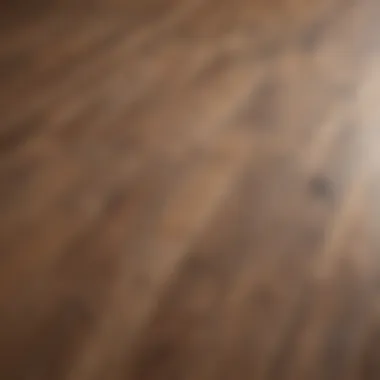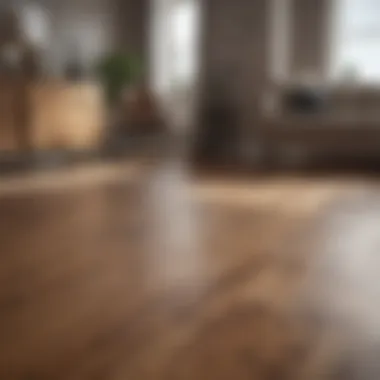Affordable Laminate Flooring Options Explored


Intro
In the quest for economical yet visually appealing home improvement options, laminate flooring emerges as a leading candidate. This flooring type is adored for its affordability, durability, and versatile design options. Homeowners and design aficionados alike are drawn to the various advantages it offers, allowing for enhancement of spaces without overspending. With an array of choices in color, texture, and styles, laminate flooring can seamlessly blend into any interior theme.
This guide will provide insights into the multifaceted aspects of dirt cheap laminate flooring. We will discuss the features that make it an attractive option, installation methods, aesthetic considerations, and care tips to ensure its longevity. Through a comprehensive comparison with other flooring types, readers will gain a clearer understanding of where laminate stands in the current market. Let’s delve deeper into the home features that set laminate flooring apart.
Understanding Laminate Flooring
Understanding laminate flooring is critical to making informed decisions about your home’s flooring options. This section aims to lay the foundation of knowledge required for readers to grasp the essential elements that make laminate flooring a popular choice in many households today. By exploring the definition, composition, various types, and key features of laminate flooring, readers will appreciate its advantages and limitations. This understanding can guide homeowners in selecting the right flooring to suit their needs, style preferences, and budget constraints.
Definition and Composition
Laminate flooring is a synthetic product designed to mimic the appearance of hardwood, stone, or other natural materials while providing various practical advantages. It typically consists of four key layers: the backing layer, the core layer, the image layer, and the wear layer. The backing layer provides stability and moisture resistance, while the core layer, often made from high-density fiberboard, adds strength and durability. The image layer features a printed design that replicates the look of traditional materials. Finally, the wear layer protects against scratches, stains, and fading, ensuring longevity. The combination of these layers results in a floor that is aesthetically pleasing yet budget-friendly.
Types of Laminate Flooring
The market offers several types of laminate flooring, each tailored to different needs and environments.
- Standard Laminate: This type is the most common and is designed for everyday use. It offers a range of design options and typically provides good durability for residential spaces. Its key characteristic is affordability, making it a favored choice among budget-conscious homeowners. However, standard laminate is not as durable as higher-performance alternatives, which could lead to quicker wear if placed in high-traffic areas.
- High-Performance Laminate: High-performance laminate is engineered for additional durability and strength. It often incorporates enhanced features that resist scratches and impact from heavy use. The notable quality of this type is its ability to withstand the rigors of active households or commercial spaces. A potential downside is the higher cost, which may not fit all budgets but can be justifiable due to its longevity.
- Water-Resistant Laminate: As the name suggests, this type specializes in resisting moisture, making it ideal for spaces like kitchens and bathrooms. The key characteristic is its ability to fend off liquid damage, thereby prolonging its life in environments prone to spills or humidity. However, potential buyers should be aware that water-resistant laminate, while more resilient than standard laminate, is not entirely waterproof, necessitating swift cleanup of any significant spills.
Key Features
Laminate flooring possesses several key features that contribute to its appeal among homeowners.
- Scratch Resistance: One of the most sought-after characteristics of laminate flooring is its scratch resistance. This feature ensures that the floor maintains its visual integrity even with heavy foot traffic and the presence of pets. Scratches can seldom penetrate the wear layer, keeping the surface looking new for an extended period. However, care should still be taken with sharp objects to avoid any potential damage.
- Moisture Resistance: The moisture resistance of laminate flooring makes it a viable choice for various rooms, especially those prone to spills or humidity. While not entirely waterproof, this feature protects against minor accidents in areas like kitchens and bathrooms. Homeowners should remember, though, that accumulated water over time can still lead to problems, so maintenance is essential.
- Ease of Installation: Laminate flooring is generally regarded for its straightforward installation process. It often uses a click-lock system, which allows for floating installations without glue or nails, making it accessible for DIY enthusiasts. However, improper subfloor preparation can lead to a challenging experience or uneven surfaces, so proper planning is necessary.
Cost-Efficiency of Laminate Flooring
The cost-efficiency of laminate flooring is a focal point for both homeowners and interior design enthusiasts. One of the main reasons laminate flooring is a popular choice is its ability to mimic high-end materials at a fraction of the cost. This attribute gives potential buyers a wide range of options without straining their budgets. In today’s economy, particularly with rising living costs, understanding the cost perspective can significantly influence decision-making in home improvement projects.
Affordability Compared to Other Flooring Options
Carpet
Carpet remains a common flooring option for many due to its softness and comfort. It is often regarded as a warm choice, making spaces feel cozy immediately. The initial cost of carpet is usually lower than laminate, especially for low-end choices. However, one of the disadvantages of carpet is its ongoing maintenance requirements; it needs regular cleaning and may stain easily. Thus, while it may seem beneficial in the short term, the long-term cost can quickly add up due to cleaning supplies and replacement needs down the line.
Hardwood
Hardwood flooring carries a reputation for elegance and durability, being a favored choice for those hoping to add value to their property. Nevertheless, the high initial cost of hardwood can be a significant barrier for many. Furthermore, hardwood requires specific types of care and is sensitive to moisture, which can lead to warping or damage. Compared to laminate, the overall affordability of hardwood cannot compete, especially when laminate materials can sometimes offer similar aesthetic value without the hefty price tag.
Vinyl
Vinyl flooring enters the conversation as another affordable option. It is often water-resistant and easy to maintain, making it a practical choice for high-traffic areas. One key characteristic of vinyl is its durability against scratches and dents. However, it's worth noting that vinyl does not possess the same visual richness as laminate or hardwood, and some may find it less appealing aesthetically. In terms of overall cost-efficiency, laminate flooring often provides a more versatile aesthetic at a comparable price point.
"Each flooring option presents its own set of advantages and disadvantages. The choice ultimately hinges on both aesthetic desires and budgetary restrictions, making cost a critical factor in decision-making."
Budgeting for Installation
Budgeting for installation is a crucial step for any homeowner considering laminate flooring. While laminate itself can be affordable, installation costs can vary. Whether opting for a DIY approach or hiring professionals, it is essential to factor in all potential expenses. DIY installation can cut costs significantly but also requires tools, time, and knowledge about the installation process.


For those choosing professional installation, it is wise to shop around and obtain quotes from various contractors. This can help pinpoint the best overall deal while ensuring quality work is completed. Additionally, considering seasonal discounts or sales can yield even better savings.
Long-Term Cost Savings
When thinking about long-term cost savings, laminate flooring stands out. It is essential to acknowledge both the durability of laminate and its resistance to scratches, dents, and water damage. Comparatively, defective planks can be replaced without significant expense, ensuring that costs remain low over time. By choosing laminate flooring, homeowners can avoid many pitfalls associated with higher maintenance flooring solutions.
Installation of Laminate Flooring
The installation of laminate flooring is a critical aspect when considering this type of flooring for your home. Proper installation ensures not only aesthetic appeal but also durability and longevity. Many homeowners opt for laminate flooring because it is cost-effective and versatile, making it a popular choice. However, the installation process demands careful attention to detail. An understanding of the installation phase allows individuals to achieve the best possible results without encountering common pitfalls.
Preparation for Installation
Preparing for installation is an essential first step. This phase involves several tasks that mitigate potential problems during the actual laying of the flooring. First, the area designated for the laminate flooring must be clear of any furniture and debris. This ensures a smooth working space, preventing interruptions. Next, assess the subfloor for irregularities. Any uneven surfaces must be leveled to provide an adequate base for the laminate planks. Finally, allow the laminate materials to acclimate in the room for at least 48 hours, as this helps them adjust to the humidity and temperature of the space.
Step-by-Step Installation Process
The installation process of laminate flooring can be broken down into a series of manageable steps. Following these steps can lead to a successful installation.
Tools Required
Gathering the right tools is a vital aspect of the installation. Essential tools include a tape measure, utility knife, tapping block, and pull bar. Each tool plays a specific role. For instance, the utility knife is used to cut planks accurately, ensuring a clean fit. The tapping block is particularly beneficial as it allows for precise tapping without damaging the planks. The mentioned tools make the installation easier and less time-consuming, making them popular among both professionals and DIY enthusiasts.
Subfloor Preparation
Preparation of the subfloor cannot be overlooked. The subfloor should be clean, dry, and level. If the subfloor consists of concrete, checking for moisture is essential, as excess moisture can lead to problems after installation. The ideal subfloor is not only clean but provides a stable base that can support the laminate planks. Additionally, using an underlayment can enhance comfort and reduce noise. A well-prepared subfloor prevents complications in the future, reinforcing why this step is crucial.
Plank Placement
Plank placement involves laying the laminate in a way that ensures a visually appealing result. Start from one corner and work your way across the room. It is crucial to stagger the seams of the planks. This method gives the floor structural integrity and adds to its aesthetic value. A uniform placement allows for a seamless look that can enhance the overall design of the space. Every plank should be checked for any gaps that could lead to complications later.
Professional vs. DIY Installation
Choosing between professional installation and a DIY project is often a matter of personal preference and budget. Professional installers bring expertise and experience, which minimizes the chances of errors. However, hiring professionals can be cost-prohibitive. On the other hand, DIY installation is feasible for those with some level of handy skills. It allows for greater control over the project and can lead to cost savings. That said, understand that the success of a DIY installation hinges on proper preparation and adherence to installation methods.
Aesthetic Considerations
Aesthetic considerations play a crucial role when choosing laminate flooring. The visual impact of a floor can greatly influence the overall atmosphere of a space. With a wide variety of styles, colors, and textures, laminate flooring offers flexibility in design choices. This aspect allows homeowners and designers to tailor spaces to match individual preferences and existing decor. As you'll see in this section, the selection of laminate flooring can enhance both the functionality and appeal of any room.
Design Options Available
Color and Finish Choices
Color and finish choices are essential in determining the look of laminate flooring. Shades range from light to dark, and finishes can be matte, glossy, or textured. Each option contributes uniquely to the ambiance of a home. Light colors, for example, can make a room appear larger and more open. On the other hand, darker shades can add warmth and intimacy to a space.
The key characteristic of color and finish choices is the ability to match or contrast with other decor elements. This versatility is particularly beneficial for those wanting to achieve a cohesive look without spending much. However, some colors may show dirt and scratches more visibly than others, which should be considered when making a selection.
Plank Sizes
Plank sizes significantly impact the overall look of laminate flooring. Standard planks can vary from narrower boards to wide, large formats. The choice of size affects not only the appearance but also the perception of space.
Larger planks can create a sense of openness, making them ideal for expansive areas. In contrast, smaller planks might be useful in intricate or detail-oriented designs. A unique feature of plank sizes is their ability to alter the rhythm of a room's design. This flexibility can cater to both modern and traditional aesthetics. One disadvantage to note is that larger planks may show imperfections more clearly, requiring a smoother subfloor for installation.


Patterns
Patterns in laminate flooring can enhance visual interest and style. Some laminates mimic the intricate designs of natural wood or stone, while others present bold, geometric options. This diversity allows designers to play with creativity.
The key characteristic of patterns is their ability to define the character of a space. For instance, a herringbone pattern can evoke elegance, while a simple plank layout offers a more understated look. However, distinctive patterns may become dated over time, so investing in timeless choices is often advisable.
Incorporating Laminate Flooring in Interior Design
Contemporary Spaces
In contemporary spaces, laminate flooring can serve as a stylish foundation that enhances modern design elements. Its ability to replicate high-end materials at a lower cost makes it appealing for many homeowners. The key characteristic of laminate in this context is its adaptability. It can suit various contemporary designs, from minimalist to industrial.
The unique feature here is the extensive range of appealing finishes, enabling homeowners to create sleek, uncluttered looks. One disadvantage is that trends can shift quickly, so continuous updates may be necessary to maintain modern aesthetics.
Traditional Styles
For traditional styles, laminate flooring provides a practical alternative for homeowners seeking classic appeal without the associated costs. Natural wood looks, rich hues, and detailed textures can replicate the charm of hardwood floors.
The key characteristic is the ability to evoke nostalgia through design. This can be particularly effective in homes featuring antique or vintage furnishings. However, the synthetic nature of laminate may not resonate with purists who prefer authentic materials.
Minimalist Designs
Minimalist designs focus on simplicity and functionality, a philosophy well-aligned with laminate flooring's clean lines and versatile options. The key characteristic of minimalist interiors is the emphasis on open space, making lighter tones of laminate flooring particularly effective.
The unique feature of choosing laminate for these spaces is the ease of maintenance and cleaning, fitting well into a busy lifestyle. On the downside, some minimalist designs may risk appearing sterile if not balanced with other elements.
Maintenance and Care
Maintaining laminate flooring is crucial for ensuring its durability and appearance over time. Laminate is designed to withstand a fair amount of wear but it requires some care to keep it looking its best. Following proper maintenance procedures can enhance the longevity of the flooring, keeping it a simple and economical choice for homeowners.
Cleaning Practices
Cleanliness is important for laminate flooring. Regular cleaning prevents dirt and debris from scratching the surface. A soft broom or a vacuum cleaner without a beater bar is recommended to collect dirt. For a deeper clean, use a damp mop with a gentle cleaning solution specifically designed for laminate floors. Avoid using excessive water because it can seep into the seams and cause damage. It's also important to wipe spills quickly to prevent staining.
Preventing Damage
Preventive care is essential to maintain the integrity of laminate flooring. Place mats at doorways to trap dirt and moisture. Furniture pads under heavy pieces can help prevent indentations. Additionally, try not to walk in high heels or with cleats, as they can cause damage. Another consideration is to control the environment; high humidity can affect laminate negatively. Keeping the indoor environment stable contributes considerably to preserving the flooring.
Repairing Damaged Laminate
Replacing Planks
Over time, some planks may get damaged due to various reasons, including moisture or heavy traffic. Replacing planks offers a straightforward solution. It is beneficial because it restores the appearance of the floor without the need for a complete overhaul. The key characteristic of this repair is its relative simplicity. Most laminates are designed with a click-lock mechanism, making replacement less time-consuming. However, it is important to ensure that replacement planks match the original in both style and size. One unique feature of this method is that it can be done without professional help, allowing homeowners to save on labor costs.
Dealing with Scratches
Scratches may appear on the surface of laminate over time, which is an unfortunate but normal occurrence. Addressing scratches promptly maintains the aesthetic value of the flooring. Fine scratches can often be buffed out using a microfiber cloth and a laminate floor cleaner. For deeper scratches, repair kits are available that include wax or fillers suitable for laminate surfaces. The distinctive advantage of dealing with scratches quickly is it helps avoid needing more extensive repairs later. Ignoring minor scratches could lead to more significant issues over time.
Sourcing Laminate Flooring
Sourcing laminate flooring is a critical aspect in the journey of selecting and installing a flooring solution that balances aesthetics and practicality. The process of identification and acquisition of laminate flooring can directly influence overall costs, installation time, and satisfaction with the final outcome. Selecting the right supplier can make the difference between a successful home improvement project or a regrettable decision. Both budget-conscious homeowners and design enthusiasts should consider important factors when sourcing laminate flooring.


Finding Reliable Suppliers
When looking for laminate flooring, reliable suppliers are key to ensuring quality and service. The flooring market can be saturated with options, yet not all suppliers provide the same level of craftsmanship or customer support. To find dependable sources, start by researching local and online retailers. Reviews can offer insight into past customer experiences.
Visit suppliers where you can physically see and touch the flooring before purchase. Many brands, like Pergo and Quick-Step, offer a varied selection that caters to different needs. It's also wise to check that the supplier has a return policy, allowing exchanges if the laminate does not meet expectations. Reliable suppliers should also provide guidance on installation, offering both DIY suggestions and professional recommendations.
Online vs. In-Store Purchasing
Purchasing laminate flooring can be done in-store or online, each method has distinct advantages and challenges. In-store shopping allows customers to assess the texture, color, and quality firsthand. This tactile experience can aid in making a more informed choice. You can also ask staff questions directly, which can be beneficial for gathering advice specific to your project needs.
On the other hand, online shopping offers convenience and a broader range of products. Retailers like Home Depot and Lowe's present extensive catalogs with often lower prices than brick-and-mortar stores. However, you lose the in-person touch and can only visualize the product from images. Using samples can mitigate this risk. It may take longer to receive orders, and it is important to read reviews and scrutinize return policies when buying online.
Navigating Sale Offers
Bargains are attractive, but navigating sale offers requires cautious consideration. Seasonal sales can yield significant savings, particularly during holidays or end-of-year clearance events. However, make sure to do thorough research to confirm that the products on offer align with your standards for quality and durability.
"Finding a great deal does not always equate to quality. It is essential to balance savings with the product's integrity."
To effectively navigate sales, keep an eye on different retailers, subscribe to newsletters, or follow brands on social media to catch early announcements. Additionally, understanding store-specific promotions can lead to lucrative opportunities. Check for multi-pack deals or discounts on bulk purchases, as laminate flooring often requires considerable square footage.
Environmental Considerations
Understanding the environmental impact of laminate flooring is integral for homeowners and designers alike. Amidst a growing focus on sustainability, various factors regarding the material's composition and sourcing come into play. This section examines the sustainability of laminate flooring materials and the eco-friendly options available, emphasizing how consumers can make informed decisions that align with environmental consciousness.
Sustainability of Laminate Materials
Laminate flooring is primarily made from high-density fiberboard (HDF), which utilizes wood byproducts. The advantage of using these byproducts is two-fold; it promotes a reduction in waste and enables a use of natural resources without extensive logging of trees. Manufacturers often claim that their products come from renewable forests, which further enhances their appeal. However, it is pivotal for buyers to verify such claims for credibility.
Also, some brands prioritize the use of low-emission adhesives and coatings, which minimize the release of volatile organic compounds (VOCs) into the environment. These low-emission alternatives are not only better for air quality but also contribute positively towards overall health in living spaces. Keep an eye out for certifications that indicate adherence to sustainable practices, such as those from the Forest Stewardship Council (FSC).
"Choosing materials that promote sustainability not only benefits the environment but also improves indoor air quality and overall health in homes."
Eco-Friendly Options
For those looking to enhance sustainability, several eco-friendly options exist within the laminate flooring market. Consumers can look for products that are made from recycled materials, aiding in minimizing waste and promoting recycling efforts. Specific brands have developed laminates entirely from post-consumer recycled content, showcasing an innovative approach towards environmentally responsible manufacturing.
Another option is to opt for laminate flooring that adheres to strict environmental standards, such as the GreenGuard certification. This ensures that the product meets criteria for indoor air quality and safety.
When purchasing laminate flooring, consider the following eco-friendly solutions:
- Recycled content: Check for laminates containing recycled materials.
- Low VOC emissions: Seek certifications that confirm low environmental impact.
- Sustainable sourcing: Research brands that commit to environmentally sustainable forestry practices.
Finale
In the realm of home improvement, laminate flooring shines as a viable and economical option. This section underscores the significance of understanding its merits in relation to cost, functionality, and aesthetics. By evaluating laminate flooring comprehensively, homeowners can make informed choices that fit both their budgetary needs and design aspirations.
One major benefit of laminate flooring is its affordability compared to traditional materials like hardwood or stone. This allows homeowners to achieve a pleasing visual effect without the burden of high costs. As discussed earlier, laminate floors offer excellent durability, resisting scratches and moisture, thus suitable for families and active households.
From an aesthetic standpoint, laminate flooring provides versatility in design. With various colors, styles, and finishes available, individuals can customize their spaces to match their personal taste or contemporary trends. This wide range of options ensures that laminate can fit into both modern and traditional interior settings.
Final Thoughts on Laminate Flooring
In light of the information presented, it is clear that laminate flooring is not merely a budget-friendly alternative but also a practical one. The ease of installation makes it accessible for DIYers, while its resilience means that it can stand the test of time in high-traffic areas. As you consider your options for flooring, keep in mind that laminate provides a perfect balance between cost and quality.
- Durability: Scratch and moisture resistance extend its lifespan.
- Affordable Installations: Lower costs than many traditional flooring materials.
- Design Choices: Various styles available to suit any decor.
Ultimately, laminate flooring serves as an excellent choice for those looking to enhance their spaces, reflecting not just functionality but also personal style. Armed with extensive information, readers can make educated decisions that contribute to both the aesthetic and practical value of their homes.



